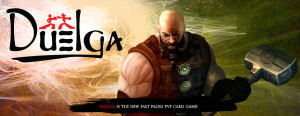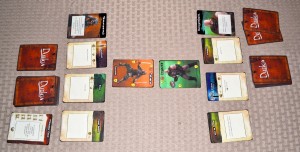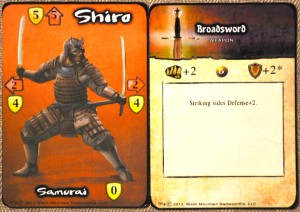The television show, “Deadliest Warrior”, attracted my attention in a way that I didn’t expect. The idea of pitting two dissimilar forces against one another to see who would win was (and still is) and intriguing prospect. “Duelga”, a Kickstarter project currently in the funding process (as of 3/1/14), reminded me of “Deadliest Warrior” almost immediately. To sum this card game up, players will choose a duelist and equip them with weapons, styles, traits, and action cards with the intent on beating the crap out of their opponent. Before we touch on the specifics though, I’d like to thank J. Sam Watson, the President of Black Mountain Gamesmiths, LLC., for providing me with a prototype copy.
It’s important to note that prototypes are often not representative of the final product, making everything featured below subject to change. With that disclaimer out of the way, I was told that the mechanics, layouts, and card quality of my copy is a near match to the final version. Some of the card art, along with the actual box, is missing however. The final design set will be a combination of male/female duelists and will practice racial diversity as opposed to the generic placeholder duelists as featured in my set. Alternate skins of the duelists are also a planned feature…all of which is dependent on the success of the Kickstarter campaign, of course.
*Editor’s Note: “Duelga” comes off primarily a 1 vs 1 game, though a team variant exists in the back of the manual that can accommodate up to three or four players.
“Duelga” comes with a number of different card types, including duelists, weapons, styles, and action cards. Using these cards, players will be building their very own characters and private arsenals. The manual does list out some suggested builds for first time players, but as you get better at the game, you can mix and match these cards via a deck-building / drafting process. Whichever way you choose to do it, each player should have one duelist, one weapon, two styles, and a twenty card deck consisting of ten attack (red) and ten defense (blue) cards. Each player begins with forty life points and the person left standing after a series of exchanges, wins the game. How you dwindle your opponent’s life force to zero all depends on the duelist, weapon, styles, and action cards chosen.
Game setup is fairly simple in that the weapon and styles chosen are placed directly in front of the player in question. The duelist himself is placed further in onto the playing field, directly in front of the opponent’s duelist so that they are facing one another. A player’s deck goes off to the side, with each player drawing two cards to form their starting hand. The first player is chosen at random. To sum up a player’s turn, they’ll: 1) Perform a movement action / Play an action card, 2) Take a strike action, and 3) End their turn.
Movement is possibly one of the most important aspects of this game, I’ve come to realize. Each duelist has varying attack and defensive values on all four sides of the card, making it important for players to position them well. The berserker, for example, has only one attack angle (straight ahead) and has equal defense on all four sides. The samurai, on the other hand, has three attack angles (straight ahead and on both sides) and has a defense value of zero on his backside. With this in mind, your movement phase will leave you wondering if you should step (move one space diagonally) or rotate your card ninety degrees. It’s worth noting that playing a red action card consumes your movement action, so tread carefully!
Combat isn’t all that complex, though it does involve a little math. If you decided to physically move or rotate your card during the movement phase, you’re left with being able to perform a “basic strike”. This is equal to your power plus weapon plus style plus any miscellaneous effect. Of course, you’ll need to make sure you have a valid attack angle to begin with. If you played a red action card during movement, you can then carry out a “strike with effect” which is equal to a basic strike plus the card effect. Strike with effects are essentially more powerful, but you have to sacrifice movement in order to do them. The damage dealt is equal to the damage done minus the total defense value, which is then subtracted from the defender’s life points (assuming the value is still positive). Blue action cards can be played immediately in response to an attack in order to help negate damage.
Ending a turn is probably the easiest step in that you’ll need to discard down to five cards, if appropriate. Once a player has completed their turn, the other player will get to take theirs. This will continue back and forth until one player has managed to reduce their opponent’s life force to zero. It’s worth noting that this game incorporates a “last in, first out” timing rule, similar to that of “Magic: The Gathering”. The last card played during a series of actions, as a result, is resolved first. If the attacker played a red action/strike card and the defender played a blue/deflect card, the deflect card is taken into account first to possibly negate the incoming damage from the strike card.
So, what’s to prevent a player from choosing all of the biggest and baddest styles and action cards? Traits. I purposely left this concept out until now, mainly because pre-built decks already factor these in properly. Traits show up on certain weapon and style cards that unlock the use of other cards. The “Fleet of Foot” red action card, for example, can’t be used unless the duelist has a weapon or style that utilizes the “Agile” trait. Traits that are provided to the duelist are shown on the middle of the card, while traits that are required in order for the duelist to use the card show up on the bottom of the card. As I indicated above, pre-built decks already factor in the proper synergy between the various card types. When drafting your deck manually however, you’ll need to pay attention to what traits you have unlocked.
While my copy didn’t include everything that would be in the final retail version, I will say that I am impressed by what I saw. There’s a lot of potential here for more duelists to be added down the line, maybe by way of an expansion or two. What attracted me the most were the customization options that were available when deck-building. Players are only limited by traits that appear on certain cards, the rest is up to the individual play style in question. Some characters are suited for one, powerful attack that does tons of damage while others excel at weaker strikes that hit more than once. You’re free to try out different combinations, much like in “Chivalry: Medieval Warfare” and its expansion “Deadliest Warrior” (a video game series with similar themes). The Kickstarter campaign started on February 26, 2014, so check it out before it passes you by!
—
You can learn more about and support “Duelga” by visiting the following websites:
https://www.kickstarter.com/projects/1957636622/duelga-a-new-martial-arts-based-dueling-card-game
—



